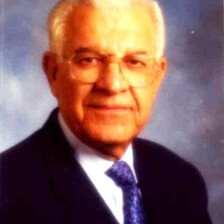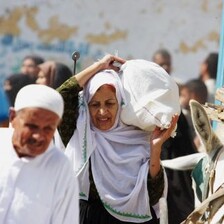
Ibrahim Bornat in his hospital bed in Ramallah. (Dina Awad)
Ibrahim Bornat, 25, from the village of Bil’in in the occupied West Bank, was shot three times in the right thigh with dum-dum bullets by the Israeli occupation forces (IOF) on 13 June 2008. Like he does every week, Ibrahim was protesting against the construction of the separation wall in his village, which will effectively result in the annexation of 58 percent of the lands by Israel. One of the bullets Ibrahim was shot with that day hit the major artery in his leg, expanding and causing major nerve damage. He lost so much of his rare AB+ blood type that an urgent alert was sent out on the radio, the Internet and at local mosques for blood donations. As Ibrahim currently lies in pain at Ramallah Hospital, he does not know if he will ever be able to walk again.
“It felt like they were trying to shoot my leg off,” says Ibrahim about the 13 June incident. The Israeli army frequently uses live ammunition at Bil’in, injuring many peace activists, sometimes quite seriously. Ibrahim, by his own admission, had been fired at and hit 77 times prior to this instance, which brings his total number of injuries to 80. Most noticeable on his body is a large gash in the center of his forehead, which comes courtesy of an Israeli soldier firing a tear gas canister at his head from close range. Ibrahim’s skull was fractured from the impact and he suffers serious memory problems.
Dum-dum bullets, the type of bullets which caused the injury to Ibrahim’s leg, are designed to expand upon impact. These bullets sometimes fragment when they enter the body. This expansion and fragmentation causes a much larger wound than would occur with a regular bullet, and results in greater blood loss and trauma. The use of expanding bullets is banned according to the 1899 Hague Convention. It’s extremely painful, save inhumane, for anyone to be hit by a single dum-dum bullet to the body, and in the case of Ibrahim, three of these expanding bullets entered the same area. His doctors have said that it would be a near miracle for him to walk again. On 28 September 2000, the first day of the second Palestinian intifada, Ibrahim’s older brother Rani was shot in the neck by an Israeli-fired dum-dum bullet that caused near complete paralysis of his body. Today, Rani can only move his head and left arm.
When Ibrahim was admitted to Ramallah Hospital, there was a shortage of blood reserves of his rare blood type, as well as a shortage of the medications necessary for his treatment. Thanks to the urgent appeal, enough blood was donated to save his life. The medication needed for his recovery costs over 1,300 NIS a week (roughly $400 US). His friends raised the needed funds for the medication in the first few weeks after he was injured. Since then, the hospital has obtained the medications, but it is uncertain how reliable the source will be and Ibrahim now worries about continuing to obtain the resources for his recovery which will likely take a year. “Where is the Palestinian Authority in all of this?” asks Ibrahim, “No official acknowledgment of my sacrifice has come from them. You would think that I acted alone that day, and not for the liberation of all of Palestine.”
The Palestinian Authority’s (PA) Ministry of Health is supposed to cover the medical expenses of those injured by the IOF. However, the ministry’s services are notorious for being far more efficient and generous for those with connections to PA officials. As Ibrahim discusses the shortcomings of health-care under occupation, he points bitterly across the street at the Shaikh Zayid hospital. Named after the ruler of the United Arab Emirates, a mass fundraising campaign was launched in 1996 to build the hospital in the wake of intifadat al-nafaq, a series of battles between Palestinians and the Israeli military over the tunnels dug underneath Jerusalem’s Haram al-Sharif that lasted for more than 40 days in 1996. “For weeks the PA had advertisements in every sort of media imaginable to raise money for that hospital,” says Ibrahim’s brother-in-law who visits him regularly at the hospital. “Everyone I know, including Ibrahim, pitched in one way or another to help build it.” The Shaikh Zayid hospital is now a private hospital where, as Ibrahim explained, “even if you’re bleeding to death, they ask you for your health insurance before thinking to stop the life from leaving your body. Poor people like us are basically not allowed on the property.”
According to Suleiman Deek, Director of the Martyrs’ Families and Injured Care Establishment of the PA, Palestinians who have been injured demonstrating against the IOF are supposed to get the entirety of their medical fees taken care of by the Ministry of Health. Ibrahim says that the PA has not helped him cover extra fees, even though he has personally approached a high-level representative for aid. When asked to comment on Ibrahim’s case, Deek suggested that Ibrahim’s family submit the receipts of the extra costs he has incurred since his injury for a reimbursement of up to 600 NIS ($180 US) a month. However, this would represent a minor part of the total costs he has incurred, and the reimbursement is not guaranteed.
No other injury sustained by Ibrahim has proven to be as debilitating as this one. Prior to being shot that day, Ibrahim was very active in Palestine’s struggle for freedom. He was a visible member of Bil’in’s popular committee against the wall. As a Fatah activist, he worked on the Popular Campaign to Free Marwan Barghouti and all Palestinian Political Prisoners. He held the post of the president of the Palestinian Students’ Support Fund, a group that works to help underprivileged students. He is also an artist, most recently putting on the exhibit From the Scent of Bil’in’s Wall to commemorate the ongoing Nakba in Palestine, art that uses IOF bullets and munitions as its main material. All of these activities were done on a volunteer basis.
Now Ibrahim finds himself immobilized in his cramped hospital room. “I can’t tell you how bad the situation is in Ramallah Hospital,” he says. “It’s dirty, claustrophobic, the nurses are overstretched, overworked, and unresponsive, and they lack many basic medications. But I am thankful for my doctors, because what they have managed to do to my leg already through their operations is remarkable … Palestinian doctors have to perform several miracles a day. I’ve spent so much of my life in hospitals that I should know.”
After being shot, Ibrahim spent seven days in intensive care. He had three operations in two weeks to attempt to patch up his fragmented artery and reconstruct his leg. The doctors implanted a vein and a nerve as well as a plastic artery. The doctors then had to clean up the damage caused by the exploding bullets by removing much of the thigh tissue. There is one more operation left aimed at helping him regain motor use of his foot. There is hope that what is left of his muscles will regenerate. However, an unanticipated twist presented itself recently, when Ibrahim woke up in the middle of the night to find his leg bleeding profusely from the latest operation. He yelled for help, but no qualified doctors were on duty. Weak and dizzy, he phoned his parents, who came from Bil’in to try and contain the blood. The neurosurgeon qualified to operate on his injury only came to the hospital hours later to treat him, by that time the situation was so bad that he had to operate immediately, and Ibrahim was given no sedatives. Now it is a waiting game. Ibrahim hopes to soon be transferred from Ramallah Hospital to a rehabilitation center, where he will undergo physiotherapy for up to a year to try and get him back on his feet. In spite of the complications, Ibrahim remains hopeful that he will be able to walk.
Ibrahim seems unsure as to whether he will go back to actively participating in his village’s demonstration against the wall once he regains his mobility. At first he says that he will no longer participate in demonstrations to show his opposition to the occupation, but struggle through his art. But after a few moments of silence, he exclaims that he is determined to go back to the demonstrations just to show the Israeli soldiers stationed there that they have not broken his spirit. Whether he returns to demonstrate in Bil’in or not, his recovery is proving to be long and arduous. He knows it may take a while, and he waxes poetic from his hospital bed: “for me, physical rehabilitation is all about morale. Morale for me comes from visitors who remind me that I demonstrated for all of Palestine that day. It comes from recognition from others that I do not struggle alone, that my injuries and physical scars are not in vain.”
Dina Awad is a Canadian of Palestinian origin who is currently living and working in Ramallah.
Hazem Jamjoum is the Media and Information officer of the Badil Center for Palestinian Residency and Refugee Rights and can be reached at mediaenglish AT badil DOT org.



